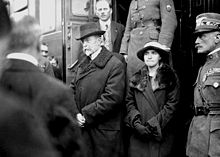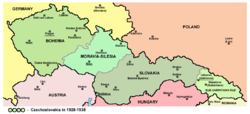- History of Czechoslovakia (1918–1938)
-
History of Czechoslovakia 
This article is part of a seriesOrigins
(1918)First Republic
(1918–1938)Second Republic and World War II
(1938–1945)Third Republic
(1945–1948)Communist Era
(1948–1989)Velvet Revolution and Democracy
(1989–1992)Dissolution
(1993)
Contents
Independence
The Czechoslovak declaration of independence was published by the Czechoslovak National Council, signed by Masaryk, Štefánik and Beneš on October 18, 1918 in Paris, and proclaimed on October 28 in Prague. Towards the end of the First World War which led to the collapse of the Austrian-Hungarian Empire, several ethnic groups and territories with different historical, political, and economic traditions were blended into new state structures. In the face of such obstacles, the creation of Czechoslovak democracy was indeed a triumph.
Initial authority within Czechoslovakia was assumed by the newly created National Assembly on November 14, 1918. Because territorial demarcations were uncertain and elections impossible, the provisional National Assembly was constituted on the basis of the 1911 elections to the Austrian parliament with the addition of fifty-four representatives from Slovakia. National minorities were not represented. Hungarians remained loyal to Hungary, and on November 12, 1918, ethnic Germans of the former Empire declared the short-lived Republic of German Austria with the intent of unifying with Germany, relying on President Wilson's principle of self-determination. The National Assembly elected Tomáš Garrigue Masaryk as its first president, chose a provisional government headed by Karel Kramář, and drafted a provisional constitution.
The Paris Peace Conference convened in January 1919. The Czech delegation was led by Kramář and Beneš, premier and foreign minister respectively, of the Czechoslovak provisional government. The conference approved the establishment of the Czechoslovak Republic, to encompass the historic Bohemian Kingdom (including Bohemia, Moravia, and Silesia), Slovakia, and Carpathian Ruthenia. The inclusion of Ruthenia provided a common frontier with Romania, an important ally against Hungary. In January 1920 Czechoslovakian army breaking prior agreements with Poland, crossed the demarcation line and by force of arms occupied the Zaolzie, where a 60 % majority of the population was Polish, compared to 25 % Czechs. After brief fights they made a truce on the power of which Czechoslovakia occupied areas to the west of Olza River. The Czech claim to Lusatia, which had been part of the Bohemian Kingdom until the Thirty Years' War, was rejected. On September 10, 1919, Czechoslovakia signed the Minorities Treaty, placing its ethnic minorities under the protection of the League of Nations.
Statehood
The establishment of the Constitution of 1920 installed a parliamentary system and representative democracy with relatively few constituents for each representative. This allowed a great variety of political parties to emerge, with no clear front runner or leading political entity.
Tomáš Garrigue Masaryk was elected the country's first president in the 1920 election and his guidance helped to hold the country together. A coalition of five Czechoslovak parties, which became known as the "Pětka" (The Five), constituted the backbone of the government and maintained stability. Prime Minister Antonin Svehla led the Pětka for most of the 1920s and designed a pattern of coalition politics that survived until 1938. Masaryk was re-elected in 1925 and 1929, serving as President until December 14, 1935 when he resigned due to poor health. He was succeeded by Edvard Beneš.
Beneš had served as Czechoslovak foreign minister from 1918 to 1935, and created the system of alliances that determined the republic's international stance until 1938. A democratic statesman of Western orientation, Beneš relied heavily on the League of Nations as guarantor of the post war status quo and the security of newly formed states. He negotiated the Little Entente (an alliance with Yugoslavia and Romania) in 1921 to counter Hungarian revanchism and Habsburg restoration.
The leaders of Czechoslovakia needed to find solutions for the multiplicity of cultures living within one country. From 1928 and 1940, Czechoslovakia was divided into the four "lands" (Czech: "země", Slovak: "krajiny"); Bohemia, Moravia-Silesia, Slovakia and Carpathian Ruthenia. Although in 1927 assemblies were provided for Bohemia, Slovakia, and Ruthenia, their jurisdiction was limited to adjusting laws and regulations of the central government to local needs. National minorities were assured special protection; in districts where they constituted 20% of the population, members of minority groups were granted full freedom to use their language in everyday life, in schools, and in matters dealing with authorities. German parties also participated in the government in the beginning of 1926. Hungarian parties, influenced by irredentist propaganda from Hungary, never joined the Czechoslovak government but were not openly hostile.
Growing conflict
Due to Czechoslovakia's centralized political structure, nationalism arose in the non-Czech nationalities, and several parties and movements were formed with the aim of broader political autonomy. The Slovak People's Party led by Andrej Hlinka is an example.
When German dictator Adolf Hitler came to power in 1933, fear of German aggression became widespread in eastern Central Europe. Beneš ignored the possibility of a stronger Central European alliance system, remaining faithful to his Western policy. He did, however, seek the participation of the Soviet Union in an alliance to include France. (Beneš's earlier attitude towards the Soviet regime had been one of caution.) In 1935 the Soviet Union signed treaties with France and Czechoslovakia. In essence, the treaties provided that the Soviet Union would come to Czechoslovakia's aid only if French assistance came first. Hitler himself remarked to his foreign minister Neurath and top military officials in 1937 that he intended to absorb Bohemia and Austria, with vogue sentence about the need to expel 2 million Czechs and eventual elimination of Czech nation[1]
The German minority living in Sudetenland demanded autonomy from the Czech government, claiming they were oppressed by the Czech government. In the 1935 Parliamentary elections, the newly founded Sudeten German Party under leadership of Konrad Henlein, financed with Nazi money, won an upset victory, securing over 2/3 of the Sudeten German vote, which worsened the diplomatic relations between the Germans and the Czechs. Henlein met with Hitler in Berlin on March 28, 1938, where he was instructed to raise demands unacceptable to the Czechoslovak government led by president Edvard Beneš. On April 24, the SdP issued the Carlsbad Decrees, demanding autonomy for the Sudetenland and the freedom to profess Nazi ideology. If Henlein's demands were granted, the Sudetenland would then be able to align itself with Nazi Germany.
See also
- Germans in Czechoslovakia (1918-1938)
- Poles in Czechoslovakia
- Ruthenians and Ukrainians in Czechoslovakia (1918-1938)
- Slovaks in Czechoslovakia (1918-1938)
- Hungarians in Czechoslovakia (Slovakia)
References
- ^ Prague in black: Nazi rule and Czech nationalism,page 108-109 Chad Carl Bryant, Harvard University Press 2007
Bibliography
- Hugh Lecaine Agnew, The Czechs and the Lands of the Bohemian Crown (Stanford, CA, Hoover Institution Press: Stanford University, 2004).
- Evans, Robert John Weston; Cornwall, Mark: Czechoslovakia in a nationalist and fascist Europe : 1918 - 1948. Oxford University Press, 2007, ISBN 978-0-19-726391-4.
- Zemko, Milan (ed.): Slovensko v Ceskoslovensku : (1918 - 1939). Bratislava : VEDA, Vydavatel´stvo Slovenskej Akad. Vied, 2004. ISBN 80-2240795-X.
- Angyal, Béla (ed.): Dokumentumok az Országos Keresztényszocialista Párt történetéhez : 1919 - 1936. Dunaszerdahely [u.a.] : Lilium Aurum [u.a.], 2004, ISBN 80-8062195-0.
- Eva Broklová: Ceskoslovenská demokracie : politický systém CSR 1918 - 1938. Prague: Sociologické Nakladatelství, 1992. ISBN 80-9010596-3.
- Axworthy, Mark W.A. Axis Slovakia - Hitler's Slavic Wedge, 1938-1945, Bayside, N.Y. : Axis Europa Books, 2002, ISBN 1-891227-41-6
- Bosl,Karl: Handbuch der Geschichte der böhmischen Länder (4 Bände). Anton Hiersemann Verlag Stuttgart, 1970
- Franzel, Emil: Sudetendeutsche Geschichte. Adam Kraft Verlag Augsburg, 1958.
- Frei, Bohumil: Tschechoslowakei. G.Alzog Verlag München, 1968.
- Meixner, Rudolf: Geschichte der Sudetendeutschen. Helmut Preußler Verlag Nürnberg, 1988.
Timeline of Czechoslovak statehood Timeline Origins
pre-1918The First Republic
1918 – 1938World War II
1938 – 19451945 – 1948 Coup d'état
1948 – 1989Velvet Revolution
1989 – 1992Dissolution
1993 –Bohemia
Moravia
& Silesiacrown lands of the Austrian Empire First
Czechoslovak Republic
(ČSR, 1918 – 1938)
Full boundaries and government established by the 1920 constitutionSudetenland
annexed by Nazi Germany
(1938 – 1945)Third
Czechoslovak Republic
(ČSR, 1945 – 1948)Czechoslovak Republic
(ČSR, 1948 – 1960)
Declared a people's democracy (without a formal name change) under the Ninth-of-May Constitution following the 1948 coupCzechoslovak Socialist Republic
(ČSSR, 1960 – 1989)Czech and Slovak Federal Republic
(ČSFR, 1990 – 1992)Czech Republic
Czechia
(since 1993)Second
Czechoslovak Republic
(ČSR, 1938 – 1939)
Including the autonomous regions of Slovakia and Carpathian RutheniaProtectorate of Bohemia and Moravia
(1939 – 1945)After the Prague Spring, consisted of:
Czech Socialist Republic
(ČSR, 1969 – 1992)
Slovak Socialist Republic
(SSR, 1969 – 1992)
Socialist dropped from names in 1990Slovakia territory of the
Kingdom of HungarySlovak Republic
(1939 – 1945)Slovak Republic
Slovakia
(since 1993)Southern Slovakia and Carpatho-Ukraine
Annexed by: Hungary
(1939 – 1945)Carpathian Ruthenia Zakarpattia Oblast of the Ukrainian SSR
(1944/1946 – 1991)Zakarpattia Oblast of Ukraine
(since 1991)see: Austria-Hungary Czechoslovak government-in-exile Categories:- History of Czechoslovakia
- States succeeding Austria-Hungary
- Czech history
Wikimedia Foundation. 2010.


